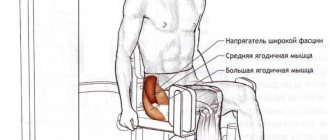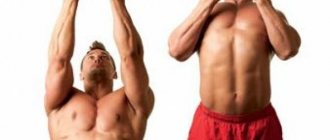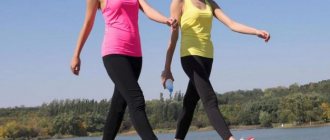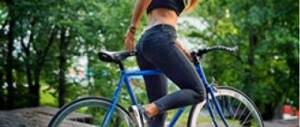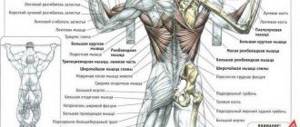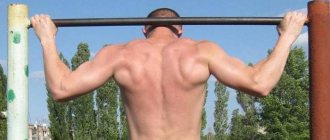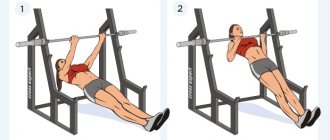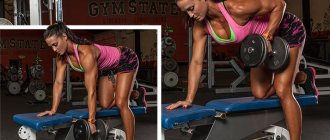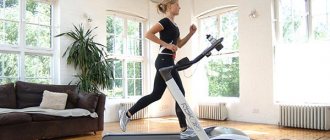Common mistakes and how to avoid them
When you do hack squats, the load is placed on the muscles and joints of your legs. The most vulnerable joints in the legs are the knees
Therefore, it is important to avoid mistakes, which we will now talk about:
- Knees point inward. You can't imagine what your knees feel like at this moment. You can easily tear the ligament and damage the cartilage. Therefore, we turn our knees to the sides. It is desirable that they are oriented in the same direction as the feet.
- When performing the exercise, the pelvis “walks”. You can get an intervertebral hernia. Press your buttocks into your back.
- The head is lowered down or raised up. The spine should be straight, with all natural curves. This way it is the strongest and can withstand heavy loads without harm to you. When performing hack squats, the load on the spine is less than with the classic version, but it is still there.
- We go down as we inhale, we rise as we exhale. The maximum load occurs when your lungs are full. This is fraught with a sharp increase in pressure in them. Of course, it’s unlikely to come to a rupture (you’re not squatting 300 kg in a hack, and whoever squats breathes correctly), but you will cause harm to the body. Remember that we stand up as we exhale. And nothing else.
- When we sit down under the weight, our heels lift off the platform. If it's because of your stretch, don't squat until you've stretched to the desired extent. If this is a feature of the body, and no matter how you stretch, there is no point - use the leg press.
- Sneakers. It is unacceptable to squat in sneakers with high and soft soles. It is best to wear weight shoes and sneakers, which must be closed. No flip flops or slippers. Shoes should be rigid and with thin soles so that the foot stands stable even under increased weight.
Basic rules and recommendations
It's never too late to listen to the advice of experts. To successfully perform squat-based exercises, you need to take into account some important recommendations:
- It is necessary to start exercising (especially with any weights) only after a good warm-up.
- The main rule is a perfectly straight back, even with a slight arch in the lumbar region. It is strictly forbidden to round your back, as this can lead to injury.
- Do not turn your head, do not lower your chin down or lift it up. You need to keep your head straight and look ahead.
- The feet and knees should be parallel to each other in all squats except plie and sumo. But in any case, the knees should not “go” inward.
Watch the angle of your hips in relation to the floor, as the muscle groups being worked depend on this (in classic squats, this angle is 90°); The correct position of various points of the body in relation to each other is important. So, socks, knees and shoulders should be on the same vertical line when lowering the pelvis
Don't lean forward too much and don't fall back. Stand with your full foot resting on your heel. When performing, watch the speed of movements. So, it takes longer to go down than to go up. On average, it takes about 3-4 seconds to lower the pelvis, and the rise should be quick. At the lowest point, you can fix the pelvis for a second, after which you can strongly push it up, focusing on your heels. When using a barbell, make sure that it is not on the neck, but slightly lower - at the top of the trapezius. When using dumbbells or kettlebells held high or low in front of you, always keep your shoulders fully squared and slightly back to distribute the weight evenly across your pecs.
Take a suitable weight limit. Too small will not give the desired result in extension; too large, in which the execution technique suffers, and can injure. The weight should be such that you can do a small number of approaches, but correctly. If your goal is not to build muscle, but to lose weight and tone your muscles and create relief, then you should not exercise with weights. Dynamic exercises that burn calories and a high number of repetitions will be enough. Jump squats are ideal for this. To make sure your exercises are as effective as possible, pay close attention to your body.
Always focus on the muscles you are working on. With such concentration, you will feel them better, you will be able to feel whether they are involved; feel where the center of gravity is and how the weight is distributed
This will help you perform the exercises technically correctly and avoid mistakes.
Proper breathing in squats is as important as the technique. You need to breathe as follows: inhale while lowering the pelvis down and exhale while fully lifting up.
Important! The mechanics of breathing are such that when you exhale, the muscles of the peritoneum relax, and when you inhale, they form into a corset in which the stomach, chest, and back are grouped
It is this kind of muscle corset that is necessary when pushing the pelvis upward.
What muscles work
The main movers here are the quadriceps and hamstrings. With a good amplitude, the gluteal muscles are included in the movement. The calves and soleus also work in this squat variation. It is a mistaken belief that the Hack squat is for beginners. An ordinary person with an office job does not have the necessary mobility in the ankles and hip joints and therefore should not squat in the Hakka.
The error occurs because the simulator turns off the abs and back. Many people find it easier to squat this way. However, such a squat is not natural for a person. In everyday life, we sit down and stand up with a slight tilt of the body forward with contracted back muscles. We need to activate these muscles to maintain balance.
The back is turned off not to prevent injury or for rehabilitation, but in order to achieve bodybuilding goals. With the help of the Hack squat, they want to “turn on” the legs and “turn off” the transverse abdominal muscles and latissimus dorsi muscles as much as possible from the process. This is necessary in order to get a load that does not increase the width of the waist. This is all true only for professional athletes, their training volumes and means of recovery. But an ordinary amateur who came to strengthen his muscles and improve his appearance, but not become a bodybuilder, should not worry about this. He is still not destined to “swing his waist” with ordinary strength exercises.
Varieties of squats
Squats can be divided into three main types: powerlifting, bodybuilding and weightlifting. They all work the muscles a little differently. For example, weightlifting squats are deeper and difficult for beginners. A lot of muscles are involved, you have to put in maximum effort. You need to do them deeply.
Powerlifting squats are done to parallel, sometimes even lower. The impact on the gluteal muscles occurs to the maximum. And the bodybuilding version is performed above parallel, the thighs are worked out well. But still, it is the powerlifting option that is more suitable for beginners.
If you want to build muscle mass, then you should take a closer look at barbell training. The barbell will help you increase the load by working the muscles of the buttocks and quadriceps to the maximum. At the same time, the soleus and adductor muscles of the thigh are also worked out. And the hamstrings, calves, abs, and back extensors work as assistants. In this case, experts recommend performing exercises with heavy weights and at an intense pace.
A variety called plie is popular; girls especially love this type of squats. These are isolation exercises. The buttocks, hamstrings, and inner thighs, which are often problematic, are worked on. But it is better to perform exercises with dumbbells, since the barbell does not complement these exercises well. Only from the point of view of human anatomy, this type is unnatural, because when it is performed, the entire load goes from the quadriceps to the biceps of the thigh and buttocks. But at the same time, this is precisely why the exercises are effective.
During plié, the soleus muscle also works - it is responsible for your support. Dumbbells take the load off other groups
The biceps work to a small extent, but the spine is unloaded - this is very important. The knee joint also takes part, which is why plies are effective and so beloved by many girls
httpv://www.youtube.com/watch?v=embed/h6oxpPpO0bQ
Exercise options
There are many variations of this exercise. But the most common are the following:
- Plie . You need to spread your legs wider, spread your toes in different directions and squat, trying to bend your legs while maintaining a right angle. In this case, you cannot tilt your body forward. The back should remain straight. During the return movement, you cannot fully extend your legs. Muscles must be constantly under tension. This type of exercise is great for women who want to enlarge their buttocks without enlarging their hips.
- Jump squat . This option is best suited for those who want to get rid of excess fat. When performing the exercise, you need to place your feet shoulder-width apart and extend your arms in front of you. After this, you should squat down to a level where your thigh is parallel to the floor. Then you need to jump up while raising your arms above your head. It should be remembered that this exercise is contraindicated for people with heavy weight, as it can seriously harm the joints.
- Squat with support . To perform it, you need to lean your back and the back of your head on the wall, place your legs 50 cm from the wall and spread them shoulder-width apart. After this, you need to squat, trying not to lift your back and the back of your head from the wall. Why is this exercise necessary? It allows you to isolate your back muscles, increasing the load on your legs.
- Deep squat with weights . Bodybuilders and powerlifters love it very much. They most often squat with a barbell. Squats with weights not only effectively get rid of excess fat, but also allow you to quickly gain total muscle mass, as it involves almost all muscle groups of the athlete’s body.
Types of squats
Classic squats with a barbell on the shoulders
Designed for the development of quadriceps, buttocks, and spinal stabilizer muscles. This technique allows you to constantly increase the degree of load, so only trained athletes should perform this type of squats. You can perform squats at different depths.
To the parallel. This option is the least dangerous for the knee joints and lower back. The lowest point of a squat is the moment when the pelvis reaches the level of the knees and the thigh becomes parallel to the floor.
Deep squats. This type requires flexible muscles, ligaments and sufficient joint mobility
The knee joints are subject to a lot of stress, so it is important to maintain the correct squatting technique. This option puts more strain on the gluteal muscles, due to their maximum extension and greater range of motion.
Front Squats
Such squats shift the center of gravity from the heels to the toes, thereby placing a greater load on the quadriceps of the thigh.
Squats with dumbbells or kettlebell
These types of equipment make it possible to perform squats for those who are not recommended to receive a compression load on the spine, this is associated with various injuries and diseases of the spine.
The weight is held in the center with both hands;
and dumbbells along the sides of the thighs.
Wide leg squats (sumo)
Allows the development of predominantly the entire adductor (inner) surface of the thigh. The atonic state (weakness) of the adductor muscles does not make it possible to fully perform all types of squats and keep the knees at one point, so the exercise improves their stabilizing function.
But girls should not get carried away with this type of squats, as it develops the volume of the adductor muscles, which makes the look less aesthetic.
Narrow leg squats
This option develops the outer thigh (abductor muscles). This is especially necessary for those who want to achieve impressive volumes of the quadriceps muscles. The buttocks work to a lesser extent in the exercise, since the squat cannot be performed deeply.
Plie squats
Similar to the sumo technique, plies maximize the development of the adductor surface of the hips. The feet are placed as wide as possible, the knees and toes are turned apart.
Single leg squats
This technique is performed with a wide stance of the legs without turning the toes, the feet are parallel to each other. When squats, the center of gravity shifts to one leg, bringing one knee to a right angle, while the other remains straight. The technique is complicated by the fact that the load falls on only one leg, and not on both at the same time. This technique develops not only the adductor, but also forms the abductor surface of the thigh.
Sissy squats
Performed with dumbbells or without weight. The peculiarity of the exercise is that when squatting, only the knee joint bends, and the hip joint remains motionless, maintaining the position of the hips and torso in the same plane. The lower parts of the quadriceps develop to a greater extent.
Pistol
It is performed on one leg; when squatting, the joints of the legs are subjected to a large load, therefore, in order to develop coordination and strength of the leg muscles using this technique, it is necessary to have high flexibility of the ligamentous apparatus.
Smith machine squats
They allow you to shift the main part of the load from the back muscles to the legs, allowing you to develop your hips and buttocks without compression of the spine. Foot placement and bar position are similar to barbell squats.
Hack squats in the machine
The exercise is performed in two ways of placing the feet - medium and wide. A special simulator shifts part of the load from the legs to the back. The exercise can also be performed with a barbell behind your back.
Tips for doing the exercise
To avoid injury and perform barbell squats more effectively, you need to follow some recommendations.
The main thing is that a good warm-up is required before performing a squat. To maintain the correct position of your back, you need to bend slightly at the lower back. The psoas muscles should be constantly tense throughout the entire approach. You can relax them only when the bar of the bar is on the stops. If you round your back during movement, this dramatically increases the risk of injury and reduces the effectiveness of the load.
During squats, the abs should be tense. This provides:
- Reliable protection of the spine, prevents displacement of the lumbar vertebrae.
- Keeping the body in a stable position does not allow swinging movements.
- But you should not overextend your abdominal muscles, otherwise this will lead to rounding of your back.
You cannot perform the exercise using only your toes. Heels off the floor reduce stability and increase the risk of knee injury. At the lowest point of the squat, the knees should not protrude beyond the projection of the big toes.
In this regard, the conclusion suggests itself: the normal amplitude of the squat is limited to the position after which the spine begins to round and the heels lift off the floor. This means that the limit of permissible movement has been reached and you need to rise.
Depending on the placement of the feet, the load on the muscles changes:
- The legs are placed narrower or shoulder-width apart - the quadriceps are more heavily loaded, squats are performed in compliance with additional safety measures.
- More shoulder width means the muscles in the back of the thigh work more actively.
In the first case, high demands are placed on the flexibility that the hip joint and Achilles tendon must have. But with a wide stance on your feet, you can take on more serious weight.
In order to simultaneously load the buttocks and leg muscles, in this case it is necessary to place the legs as wide as possible, with the toes fully turned out and maintaining a right angle in the legs (when squatting, the knee should not go beyond the projection of the toe). This is good for working the inner thighs.
Alternate the standard squat with these variations:
- plie (wide stance of the legs, toes turned to the sides);
- sumo (wide stance of the legs, toes turned to the sides, buttocks lowered as far as possible).
How to increase your barbell squat?
Every second gym goer wonders how to increase a barbell squat. There are many methods, but the point is always in two aspects: proper cycling of loads (using percentages and alternating light/heavy training) and performing auxiliary exercises. In practice, a competitive powerlifter will typically do two squat workouts per week, one with a weight equal to 50-60% of the maximum for 5 reps for three sets, and the other with a weight equal to 75-85% of the maximum. maximum, 5 repetitions in five approaches. Closer to the competition, the weight of the bar increases, and the number of repetitions decreases.
When it comes to accessory exercises, the most commonly preferred exercises are pause squats, front squats, barbell bend-overs, bench squats, and overhead squats.
- Pause squats are a type of squat in which the athlete works at the deepest possible amplitude, fixating for a few seconds at the lowest point. The upward movement is explosive in nature, thereby significantly increasing the speed of the lift during normal squats.
- Front squats differ from classic squats with a barbell in the position of the bar - here it is on the chest. Thanks to this, the vector of movement changes slightly, and the quadriceps receives a more serious load.
- Bent-overs are extremely important for strength athletes because they help keep your core more stable during heavy squats.
- Bench squats are a type of squats with a shorter amplitude (we lower ourselves above parallel), where our task is to lower ourselves to the level of the bench.
- Overhead squats are a coordination exercise that are quite challenging for beginners. Helps you get a better feel for corners and blind spots.
» alt=»»>
httpv://www.youtube.com/watch?v=embed/zG-MeFbhQc8
What muscle groups are involved?
In order to choose the right set of exercises for yourself, and it will be effective, you need to know which muscles work during squats. The main ones are:
- The quadriceps femoris (quadriceps muscle) is the front part of the thigh. She is responsible for ensuring that the leg straightens at the knee joint.
- The biceps femoris (biceps muscle) is the back of the thigh, responsible for bending the leg at the knee and straightening at the hip.
- The adductor muscles of the thigh are the inner surface of the thighs. Helps move the leg to the side.
- Gluteal muscles - large, medium and small. Multifunctional, responsible for all movements of the lower half of the body.
- The gastrocnemius and soleus muscles are the lower legs. Participate in maintaining balance and promoting upright walking.
Additional stabilizer muscles that work during squats also perform important functions:
- Dorsal. Helps maintain a straight back during exercise. Mainly the muscles of the lumbar region are involved. However, with the correct distribution of the load and center of gravity, the back should only be responsible for its even position. The back muscles are not pumped during squats, as this is ineffective and unsafe.
- Press. Only the lower and middle ones are used. Responsible for maintaining the peritoneum in tone and forming a muscular corset around the internal organs, helping to maintain position and balance.
Did you know? In men, weighted squats increase testosterone levels.
The muscles involved in squats are the same in both men and women. There are no anatomical differences when performing the exercise. However, differences in muscle architecture between the sexes are obvious. This is not due to the different influence of squats on muscles, but to the fact that men and women set different goals in pumping and therefore work on different muscle groups. The differences in how squats are performed determine which muscles are affected and which ones will grow or change their definition accordingly.
So, guys first pump up their quadriceps and hamstrings, as well as their calves. They don't need rounded buttocks. Therefore, they perform exercises that are most effective for the leg muscles (for example, plies, squats with legs together, or high squats with a barbell). The quadriceps swing precisely when the pelvis is lowered - so that the thigh is parallel to the line above the floor.
Read more about the benefits of squats for the body of men and women.
Girls have different goals. They strive to form rounded buttocks (and this is possible if they develop the gluteal muscles as much as possible). To achieve results, squats are used with a deep lowering of the pelvis and moving it back (for example, “sumo”).
Beginners who have only recently started using such exercises in their training are interested in which muscles should hurt after squats. For example, girls wonder why their buttocks don’t hurt after training. The fact is that the part of the body that worked will hurt. This answer to the question concerns not only representatives of the fair half of humanity.
Important! Painful sensations should be present in all muscles that were involved in each specific exercise. Pain will occur, but only if the muscle fibers have received maximum load.
Muscles hurt after squats
There is a widespread belief among athletes that muscle pain indicates the effectiveness of training in the gym, and the more intense it is, the better the training went. Actually this is not true. There are different types of pain syndrome, it is important to distinguish between them and in time to help the body cope with unpleasant sensations.
The nature of pain
To figure out whether your muscles should hurt after a workout, find out why the burning sensation in your muscles occurs. The nature of the pain is associated with tearing of muscle fibers. Most often it is observed in beginners whose muscles are not adapted to the load. Also, a similar symptom occurs in experienced athletes if they have not trained for a long time or have changed their exercise program.
This pain is normal, and with systematic exercise for 1-2 weeks it will disappear. Physically, it does not affect the effectiveness of training, but it interferes mentally, because it is much more difficult to exercise while experiencing unpleasant sensations.
During intense physical activity, micro tears form in the fibers. After a while they heal, the cells begin to actively divide, the fibers thicken and stop tearing. When changing the program, the athlete trains other muscle groups, so the pain may reappear. The muscles will again need a few days to adapt.
What muscles hurt after squats is often of interest to girls who exercise their buttocks. Don't be surprised if pain occurs in your calves. It is they who bear the main load and stretching when performing the squat complex.
Types of soreness after training
When wondering whether muscles should always ache after exercise, it is important to understand that everything is very individual. Much depends on genetic predisposition, gender, and physical characteristics. In girls, the adaptation of fibers takes longer, so the muscles hurt more often, and the nature of the pain is more intense. Pain syndrome in athletes can be one of three types:
- Moderate muscle pain after exercise. It occurs due to the fact that lactic acid (lactate) is produced in the muscles and fiber tears occur. This is the right pain that does not interfere with muscle functions. It goes away in 2-3 days.
- Delayed muscle pain or LMS. It occurs the next day after intense exercise. It prevents complete restoration of muscle fibers and interferes with contraction. This feeling occurs if you significantly increase the volume of load or weight. It goes away within 4 days, but it is important not to stop exercising. And during training, reduce the load by half.
- Pain as a result of injury to muscle tissue . The muscles ache and hurt. Any movement causes stiffness and discomfort, redness, inflammation and general malaise. To recover, it is better to stop visiting the gym for a while. Is it necessary to quit classes? No, but the training scheme should be as gentle as possible.
How long should athletes train? A personal question. In normal condition, muscles should not hurt after training, because they are accustomed to the load. If you deviate from the program, pain occurs, but with the right approach, the discomfort will quickly pass.
How to eliminate this disease
Even normal pain after changing a program or a long break causes discomfort in the athlete. Every training turns into terrible torture. You need to help yourself cope with the pain. What can you do to make your muscles stop hurting after every workout?
First, you need to establish nutrition. Your diet should contain proteins, fats and carbohydrates every day. The protein norm is 2 grams per 1 kg of athlete’s weight, and carbohydrates 2-4 grams. Include foods rich in Omega-3 and Omega-6 in your diet.
It is important to increase the volume of fluid consumed, start taking ascorbic acid. Before exercise and after a set of exercises, you need to stretch your muscles, give them time to relax and rest. After training, visit the sauna, take a contrast shower, and order a massage.
The time spent in the hall should not exceed 1 hour, maximum 90 minutes. If muscle pain does not go away, you should purchase pain-relieving gels and ointments, which are sold at any pharmacy. It is also important to increase your sleep time. Healthy sleep helps restore the entire body. The norm of rest at night for an adult is 7-8 hours.
Doctors and experienced athletes recommend not to overload the muscles during training. It is better to gradually increase the load. From systematic, but moderate loads, the effect will be much more noticeable than from accelerated programs. Balance is important in everything, take into account the needs and resources of your own body, and then unpleasant sensations can be avoided.
about how long muscles are restored:
Source: https://BoliGolovnie.ru/varikoz/boljat-myshcy-posle-prisedanij.html
Types of squats and muscles
In fitness, there are many different squats that target specific muscle groups. Let's look at the most popular and accessible to everyone:
- All 4 heads of the quadriceps, the lumbar region and buttocks are pumped while building strength in squats with a barbell. This exercise can be perfectly performed by short people, as practice shows.
- Plie squats effectively train the inner thighs. The difficulty of doing this is that you will need good coordination.
- Powerful basic work of all muscles of the lower body is ensured by sumo squats with wide legs. This exercise is great for beginners, teaching proper technique while putting minimal stress on the knee joints.
- One of the most rare exercises in the gym are frontal exercises with the barbell placed on the chest. The main load is directed to the quadriceps, the auxiliary load is distributed to the calves, buttock muscles and hamstrings.
- You can perform heavy squats with dumbbells - they are placed on the shoulders and below in the lowered arms. The buttocks, front and back surfaces of the thighs and a little back with the abs are loaded.
- Bare squats are suitable for improving overall fitness, but not for building muscle mass.
- By squatting on one leg, the muscle mass develops collectively, showing how strong your legs are.
- Narrow stance of the legs during squats puts increased stress on the quadriceps - the front surface of the thigh. But the buttocks do not receive enough of it due to the inability to squat deeply.
To maximally work out muscle groups, you need to have knowledge of the correct technique and strictly follow it. I do not recommend deep squats for women and girls who want to lose excess weight - such workouts, and even with the use of additional weights, are suitable for men to build muscle mass.
Start small - 2 approaches, in each of which you need to squat at least 12 times, gradually reaching 3-5 with the number of repetitions up to 20-30.
Do not forget to also regulate your diet, which is an integral part of the entire process of shaping your body.
Classical technique
There is a basic squat technique that is common to most similar exercises. It should be carefully disassembled before starting classes:
- We place our feet shoulder-width apart, parallel to each other.
- Body weight is distributed over the entire surface of the feet.
- We lower our arms freely to our sides.
- We keep our head straight and constantly look forward.
- We tighten our stomach, inhale, and smoothly lower our pelvis.
- At the same time, we bring our arms out in front of us to the horizontal.
- We don’t linger at the bottom point—exhale and return to the vertical position.
Having learned how to squat correctly using the classical technique, try to shift the emphasis of the load. This will help to qualitatively work out individual muscle groups.
For example, an exercise with a wide stance allows you to fully load the buttocks and stretch the inner thighs. This variation is often used by girls to work out problem areas.
Another example is squats with narrow leg stance. They have an accentuated effect on the quadriceps. The exercise is usually performed with additional weights and is used by men to increase the strength and volume of the lower extremities. Girls are recommended to do narrow squats in the Smith machine. This will dry out your thighs and make your legs slimmer.
Now about the depth of the squat. For beginner athletes with weak thigh muscles, we recommend lowering the pelvis to a right angle at the knee joints. This technique specifically strengthens the femoral part of the legs. Experienced athletes (without medical contraindications) can lower themselves into a squat “all the way.” This will allow you to better stretch your gluteal muscles and also increase your strength.
Varieties of squats
There are enough exercises of this type to choose the ideal option for yourself, alternate between certain types of loads and harmoniously develop your body.
Barbell squats with increasing strength. Ideal for short people. Quadriceps, lower back, buttocks sway. "Sumo". These squats are characterized by a wide stance of the legs.
They put a load on the entire lower body, and its correct distribution occurs, which is very important for beginners. For sumo squats, you need to place your knees as wide as possible
This position provides stability and helps improve coordination during execution. "Plie". This is an ideal exercise for the inner thighs, which are not so easy to tighten. It is important to remember that it is quite difficult to maintain stability in this position, so coordination to perform it must be quite good. A difficult but effective exercise - with the frontal holding of a barbell on the chest. At the same time, the quadriceps are worked out, and to a lesser extent the hamstrings, calves, and buttocks. It is effective for “experienced” to squat with dumbbells pressed to the chest or in lowered hands. This makes not only the buttocks and back of the thighs strong, but also the back and abs.
Not every woman has the opportunity to visit the gym. This especially applies to mothers of children who find it difficult to leave home. I must say that they found a way out: many study in their own walls, using improvised means. If you take the correct position and do not disturb your breathing technique, such exercises will help improve your body.
httpv://www.youtube.com/watch?v=embed/TVX98wtjvFM
The Positive Effects of Squats
The main advantage of the exercise is its complex effect. An athlete who uses squats in training develops not only muscles, but also improves body function:
- Strengthening the heart . High-speed multi-repetition squats without additional weights are equivalent in effectiveness to full-fledged cardio exercises - the main training of the heart muscle and increasing endurance.
- Mass gain . We are talking about exercises with power equipment. Squats with a barbell on the shoulders provide a powerful boost to the production of growth hormones, which makes the element basic in the training program of bodybuilders and powerlifters.
- Strengthening the male reproductive system . Athletes who regularly squat with a barbell or other weights improve blood circulation in the pelvic organs, which helps to improve the genitourinary system and restore libido.
- Lower body workout for women . Most gym goers dream of having toned thighs and round buttocks. Squats help to specifically load these muscle groups and get rid of flabbiness.
- Losing weight . The reduction of subcutaneous fat depends on the energy intensity of the exercise. Squats force large muscles to consume a large number of calories, which means getting rid of extra pounds and cellulite.
The exercise is used to recover from sprains and injuries. Light squats of half the amplitude without additional weight will help strengthen joint tissues and tendons and return mobility to the athlete.
Technique for performing a deep squat with a barbell
Once you have mastered the technique of deep squats, you can use additional weights. Weighted squats will help build muscle mass in your buttocks and thighs. However, unless you are a professional athlete, doing deep squats with heavy weights is not recommended.
It is best to start working with weights in a Smith machine, since in this case it will be easier for you to maintain balance and perform the exercise correctly. After this, you can try squats with a light weight or an empty bar. In this case, the projectile can be placed on the back or on the chest.
Let's take a closer look at all three options.
Deep squats in a Smith machine for beginners and girls
Beginners should pay attention to this particular exercise, since here the apparatus is fixed, which eliminates the risk of falling back and makes it easier to place the load on the heels. To learn how to squat deeply, a safer starting option is Smith machine squats.
To learn how to squat deeply, a safer starting option is Smith machine squats.
Technique:
- We place the barbell on the upper back muscles, on the trapezius. Never place the bar on your neck.
- We remove the barbell from the clamps and take a half step or a step forward.
- Place your feet shoulder-width apart or slightly wider.
- Toes point straight or slightly to the sides.
- As we inhale, we slowly lower ourselves forward, do not dive, but gradually perform a squat.
- At the lowest point, we linger for a few seconds and, as we exhale, we slowly rise up.
- At the top point we tense our buttocks.
With the Smith machine, you can step far enough forward and perform squats without the risk of falling back because the barbell is holding you up. This allows you to sit up with your pelvis moving much further back than you would be able to with a regular barbell. Thus, the muscles are worked more deeply, and the load on the knees is reduced.
Start with 8-12 squats in 3 sets. Gradually increase to 12-15 times in 4 sets. Also, to build muscle mass, it makes sense to increase the weight of the projectile.
Video: Smith machine squat technique
httpv://www.youtube.com/watch?v=embed/poXUp3EF1Dw
Deep squats with a barbell on your shoulders
Before starting a workout, be sure to do a good warm-up to warm up your muscles. To prepare the lower back, which receives serious load during such squats, perform the hyperextension exercise in 2-3 sets of 15-20 times. Then do a few squats without weight and with an empty bar, and only then proceed with working approaches.
You should move on to deep squats with a barbell only when you have mastered the technique of the exercise well.
Technique:
- Step up to the rack and place the bar on your upper back and shoulders.
- We have a medium grip on the hands.
- Remove the apparatus from the racks and take a step or two forward or backward (depending on how the simulator is positioned).
- The gaze should be directed straight or slightly upward, do not lower your head.
- The back is straight and rigid. For safety, you can use a special belt.
- We place our feet shoulder-width apart, with our toes pointing straight or slightly to the sides.
- We begin to lower ourselves down while inhaling, moving the pelvis back.
- Having reached parallel, do not dive down sharply, do everything smoothly and slowly.
- Hold at the bottom for a couple of seconds, then exhale and return to the starting position.
The number of repetitions in a working approach should be small - up to 15 times, 3-4 approaches will be enough.
Technique for performing deep squats.
Deep squats - front grip
This version of the exercise is more suitable for experienced athletes.
During squats, you can hold the barbell not on your shoulders, as most people are accustomed to, but also on your upper chest.
In this case, the barbell can be held with a direct grip, as in the photo above, or with a cross grip, as in the photo below.
How to hold the barbell—with a straight or cross grip—depends on the athlete’s personal comfort.
In general, the technique is the same as during squats with a barbell on the shoulders, so we will not dwell on this in detail. Let's better talk about the exercise itself - whether it is worth it or not.
As we already mentioned, the load on the back, especially on the lower back, during deep squats is very significant, especially if there is additional weight on the shoulders, so it makes sense to try this version of the exercise to reduce the load in the back area.
Additionally, if you're looking to mix up your workout and try a really challenging variation of the squat, then this is the exercise for you.
If the exercise is difficult, the barbell can be replaced with dumbbells.
Number of repetitions: 8–12 in 3–4 sets.
How to do squats?
No matter how many exercises an athlete plans to include in a workout, he always needs to warm up before performing them. To do this, you need to do 5 lunges on different sides, leg presses from a lying position. Another option to warm up your muscles, ligaments and joints is to connect to cardio exercises in the form of a treadmill.
In bodybuilding, the weighted squat is considered to be the best exercise for increasing muscle mass. Moreover, its effect is that it helps growth not only in the legs and buttocks - even the pectoral muscles gain volume and abs.
The main variations of squats can be divided into three. These are classical, plie and sumo. How to perform them and what is training in them? When performing the plie exercise, the hamstrings, gluteal muscles, abs are loaded, and most importantly, the area of the inner thigh is worked out.
For girls, the plie squat allows you to pump up your buttocks without building up the quadriceps muscle of your legs. It is too voluminous and does not look very nice on women.
For a plie squat, use one dumbbell with a working weight of 4 kg. At the same time, it is held vertically with both hands. The alignment of the pose begins before performing the exercise: standing straight, toes pointing to the sides, heels touching. The body is straight, the stomach is tucked. Holding a dumbbell, do a plie, while the tailbone drops vertically down, the knees move to the side. At the bottom point, it is better to pause for a few seconds and return to the starting position. The athlete must keep his buttocks tense throughout the entire exercise. Perform 10–15 repetitions in 2–3 approaches. You can rest 1-2 minutes between sets.
The sumo exercise is very similar in technique to plie. The only difference is the wide stance of the legs. In sumo they are placed about 1.5 times wider than shoulder width. Why approximately? Because the width of your feet will be different for everyone. They pick it up by sitting in the correct position until it is parallel to the floor. The thigh is brought into parallel.
This squat is suitable for both men and girls. It is especially recommended for the latter, because sumo works the inner thigh, which is not easy to reach with regular exercises.
During execution, you should not round your back. It should be level and maintain a natural deflection in the lower back area. The heels should not leave the floor throughout the entire execution. It is important for your knees to point in the same direction as your toes.
How many times should I do it? For people of average fitness level, 3 hikes of 10–15 times are enough. For those who are more physically prepared, you can take more weight or add 1 approach. For complete beginners, it is better to halve the number of repetitions in a set and be sure to stretch the inner thigh. It is recommended to do classic exercises correctly before mastering sumo.
The sumo squat exercise is only suitable for those who have normal mobility in the hip and knee joints.
What is the harmful effect?
Unfortunately, the squat exercise, in addition to its benefits, also has harm, this is especially important for women. As our grandmothers say, “you still have to give birth!”
Yes, indeed, women shouldn’t get too carried away with super-high weights. And, most importantly, the correct execution technique plays a huge role here. If you don’t follow it, any benefit goes to waste.
- When we talked about what squats do for girls, we mentioned strengthening joints and ligaments. But, if you overdo it with weights, the opposite effect occurs - the risk of sprains and injuries. The knees are especially affected - over time, the joints can become inflamed and abrasion of the cartilage tissue will occur.
- Excessive axial load on the musculoskeletal system can cause intervertebral hernia or damage to the Achilles tendon.
- The question “are squats good for overweight women” is controversial, because it is a kind of load on the joints. Therefore, if you are obese, you should squat with an elastic bandage wrapped around your knees, and not get carried away with a large number of repetitions. Practice moderation.
The latter applies to all situations. Don't try to overload your body. Work with adequate weight and increase the load in stages. In this case, you will feel all the benefits of the exercise.
Well, now you know how squats are beneficial for a girl’s health, and you are also warned about possible harmful consequences. To avoid them. Don't forget to squat correctly. Finally, let's talk about how to maximize your benefits.
Basic mistakes in squats
Mistakes often lead to ineffective exercises or even cause injury.
Pay attention to the most common ones:
- insufficiently warmed muscles, which is why they are not at all elastic and can even tear;
- shallow lowering of the pelvis during air squats, so the legs and buttocks do not receive the necessary load;
- a rounded back is fraught with lower back injuries;
- knees fall inward;
- incorrectly selected posture without taking into account anatomical features;
- dangling arms that do not participate in maintaining balance;
- a body that leans forward or backward;
- the additional weight is incorrectly chosen - too small or too large;
- squats with a barbell without insurance;
- lowering the pelvis too quickly;
- sudden movements;
- lack of coordination of movements when body parts or projectiles “walk” from side to side;
- lack of concentration on the working muscles, which can lead to serious mistakes.
Video: 5 mistakes when doing squats
Based on the above, we can conclude that squats are one of the most effective exercises for training the lower body. It is basic in any sport. By regularly squatting, you can not only improve your physical condition, but also give your body an attractive appearance.
Benefits of squats
What do squats do? This versatile activity is suitable for bodybuilders and those wanting to lose weight. Squats help girls actively burn fat, so they are indispensable for weight loss and are needed by everyone.
Due to the fact that several muscle groups are involved, the exercise is universal and functional, and you can build workouts on it. This gives space for the imagination of coaches and athletes.
Thanks to the work of the stabilizer muscles, you get a whole complex that activates the entire lower body. The squat provides a load that allows you to start the work of the cardiovascular system. It develops and trains the muscles of the legs and buttocks. You should understand the effects of improper training. If you bring your knees forward, you can injure them along with your hip.
The effect of squats will only be achieved with the correct technique. You should start with a basic squat and only after honing the technical part should you start working with dumbbells and a barbell. It is advisable to consult with a fitness trainer so that he can select a set of squats based on your goals and objectives.
Within the walls of the “YourRevolution1905” club, we are ready to professionally help you tighten your body and improve your physical shape. Whole sets of exercises developed by certified specialists, nutritional recommendations, “smart” weighing and much more, all this will help you achieve your goal as effectively as possible. For the most effective and quick results, you can train individually (one-on-one with a trainer) or in mini-groups of up to ten people. Come to our classes and we will help you become the best version of yourself!
Basic mistakes when doing squats
The correct exercise technique helps to maximally work out the muscles that work when squatting and minimizes the risk of injury due to the increased load on the back and knee joints. To make the exercise as safe as possible, familiarize yourself with the main mistakes when performing it and try not to make them.
- Knees extending beyond the toes. A fairly popular mistake among beginners. The danger is that the joints are over-stressed, increasing the risk of sprains and injury. Let your knees be in line with your toes.
- Excessive relaxation of the shoulders and back. If your back automatically rounds when squatting, you need to work on it. If it is level, the spine is in a neutral position, making the exercise safe and effective. To do squats, you already know which muscles work, and work your core, you can lower your shoulder blades down a little.
- Insufficient squat depth. Many beginners are deeply afraid of squatting, because they believe that this increases the risk of knee injury. In fact, if you do everything correctly, there is no danger in this, but the effectiveness is very good. Watch how low your hips go: they should go below knee level. Then squats, which muscles are involved you know, will be as effective as possible.
- Insufficient regularity of squats. It is recommended to include squats in every workout, performing them at least 2-3 times a week. To work different muscle groups when doing squats, combine different types of them.
Let's look at how to properly perform a classic squat using your own weight. This technique involves the following nuances:
- Stand straight with your feet slightly wider than shoulder-width apart.
- Shift your weight into your heels and arches.
- Your knees should be over your ankles and your hips over your knees.
- As you move, keep your spine in a neutral position. He shouldn't overexert himself.
- You need to extend your arms in front of you and place them in a position parallel to the floor. Palms should be facing down.
- Inhale and begin to slowly move your hips back, bending your legs.
- Look forward at one point, keep your back straight, do not round it or lower your shoulders.
- As the squat deepens, focus on keeping your feet and knees in line.
- Try to go as low as you can. You can lower your hips to knee level or lower.
- Returning to the starting position, push off with your heels. This will help to engage the core muscles in the exercise. published econet.ru.
Leg muscles hurt after squats
For everyone who strives to lead a healthy lifestyle, exercise becomes necessary. However, often, especially unprepared people, experience pain in their legs after squats. This may cause doubts about whether everything is in order with your health, as well as whether sports exercises are performed correctly.
It is very important, especially for those who exercise without a trainer, to study for themselves the possible causes of certain sensations, especially pain, so as not to cause harm to health and the body. We will tell you in this article why your legs can hurt when squats, as well as why pain in the hips, knees and ankles can occur when playing sports.
Lactic acid production by muscles
The most common reason why legs hurt after squats is the formation of lactic acid in the muscles.
It is this liquid that causes pain, called sore throat - after squats, every athlete, without exception, encounters it in the initial stages of training.
This pain also occurs if you start squatting after a long break, or if you do new exercises that load muscles that were not previously involved in the training program.
The mechanism looks counterproductive, especially if you seriously intend to significantly strengthen your muscles in the shortest possible time.
However, this mechanism was not invented by nature by chance - it protects the muscles from excessive stress, which can harm them or even destroy muscle tissue.
Therefore, there is nothing wrong with such pain - as physical activity increases, provided it is regular, the pain will stop bothering you. So continue to squat, increasing the number of approaches - do squats, for example, both in the morning and in the evening.
Violation of exercise technique
Another reason why your legs hurt after squats is improper execution of the exercises. The problem especially often arises among those who train independently, and not under the guidance of a trainer. It would seem that squats are the simplest exercise, what can you do wrong?
Not everything is as simple as it seems. If you perform squats without understanding the technique, you may not benefit, but cause harm to the body . For example, if your legs are too wide apart or your feet are turned incorrectly, the load that you give to your legs when squatting is not directed to the leg muscles, as it should be, but to the knees or ankle joints.
This situation is fraught with injuries - and they often occur. For example, your knees and feet may hurt or “crunch.” In the worst case, you may suffer a dislocation.
Old injuries
Another reason why your legs hurt from squatting is old hip, knee, or ankle injuries.
They can make themselves felt again, especially if you exercise intensively or do not properly follow the exercise technique.
Athletes with injuries need to be extremely attentive to these vulnerable areas, it is better to warm them up and “warm them up” during exercise, and also not to overload them.

